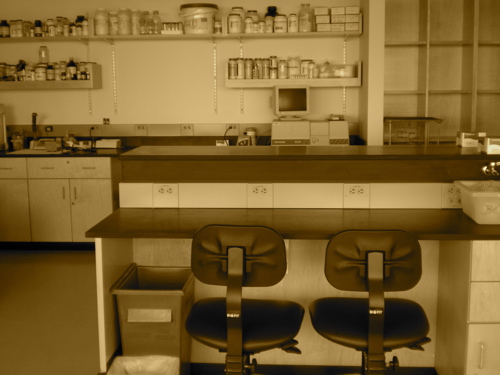20.109(S10):Aptamer binding assay (Day7)
From Course Wiki
Revision as of 20:54, 24 February 2010 by AgiStachowiak (Talk)
Contents
Introduction
Do some big picture wrap-up about aptamers and their utility here.
Protocols
Part 1: Purify, quantify, and prepare RNA
Repeat the Day 4 protocol, parts 1 through 3. That is, briefly:
- Purify the RNA on a Micro Bio-Spin column.
- Quantify the RNA by spectrophotometry.
- If you have less than 1.4 nmol of either "post" sample, let one of the teaching faculty know.
- Dilute each sample to 8 μM in the selection buffer (SB).
- Note that to dilute your post-column sample, you will have to make an educated assumption about the ratio of 6-5 to 8-12, because they do not have the same molecular weight. What do you expect to have happened on the column?
- Finally, denature not only your "post" samples, but also your four "pre" samples, at 70 °C and then let them cool for at least 10 minutes.
- If you are missing some "pre" samples due to low RNA yields, let the teaching faculty know; we have extra 6-5 and 8-12 to give you.
Part 2: Binding assay
- Retrieve some 6 μM heme from the teaching faculty. Why might you use 6 μM instead of 8 μM, if we want 1:1 molar RNA:heme?
- A 1M stock solution of heme was originally prepared in DMSO, then diluted in multiple steps to 6 μM. Note that the stock solution is prepared by dabbing a little (solid) hemin into DMSO, and then testing the concentration on a spectrophotometer. The extinction coefficient of heme at 405 nm is 180 mM-1cm-1.
- For each sample in the table below, add 175 µL of heme solution to an eppendorf tube.
- Now add 175 µL of selection buffer to the first tube. To the remaining tubes, add 175 µL of the appropriate aptamer solution.
- Incubate for a minimum of five minutes at room temperature.
- Meanwhile, unwrap some microcuvettes, one for each sample. Add 350 µL of selection buffer to the first cuvette.
- WARN THEM ABOUT BUBBLES
- Blank on selection buffer alone. Then, beginning with the heme sample, read the spectrum from 350 to 425 nm. It is essential that after each reading you send that data to the attached USB key. To do this hit More on the touchscreen twice, then press Send Data. You should also note down the absorbance value at 405 nm, and observe whether the peak appears to have shifted away from 396 to 405 nm.
Part 3: Begin analysis
You may want to start your analysis in lab, or wait until later. The directions below provided an outline of the steps you need to take.
For next time
- Your first draft of the laboratory report is due...
- Your computational assignment is due...
- Your first self-assessment is due, as a hard-copy.
